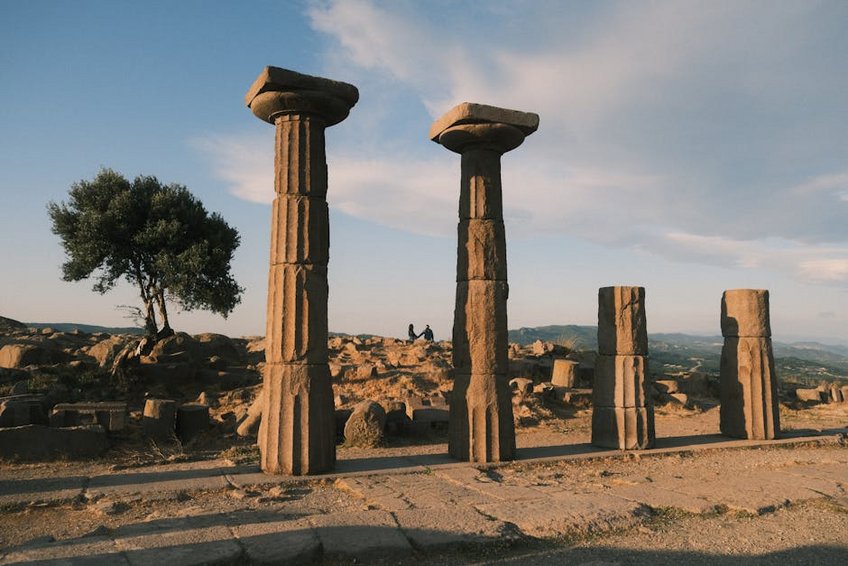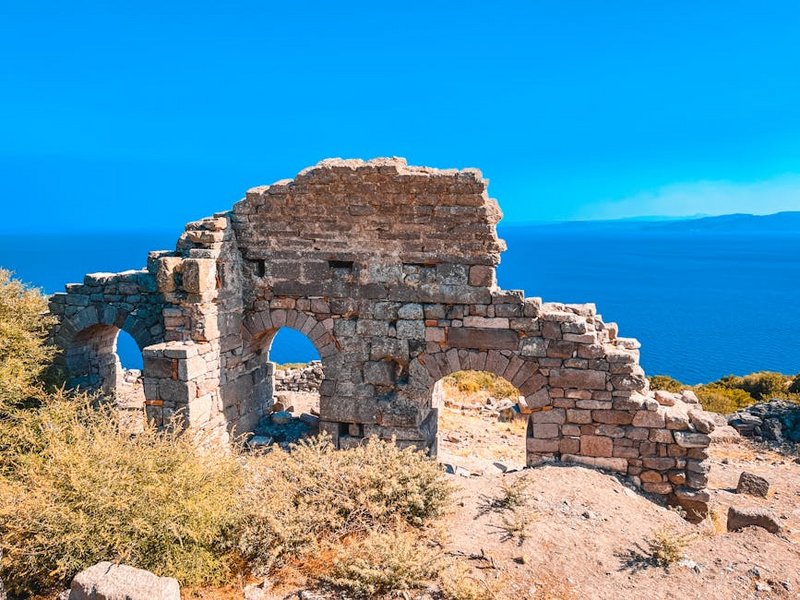Assos Ancient City: Your Complete Travel Guide to Turkey’s Aegean Gem
Perched dramatically on a volcanic hill overlooking the sparkling Aegean Sea, Assos Ancient City offers one of Turkey’s most breathtaking archaeological experiences. This remarkably preserved site combines extraordinary history with stunning natural beauty, creating an unforgettable destination for history enthusiasts, photographers, and travelers seeking authentic cultural experiences. Walking through the ancient stone streets of Assos, you’ll follow in the footsteps of Aristotle, St. Paul, and countless other historical figures who found inspiration in this magical location. The city’s magnificent Temple of Athena provides panoramic views that will literally take your breath away, while the nearby fishing village of Behramkale offers charming accommodations and fantastic seafood restaurants. Whether you’re planning a day trip or an extended stay, Assos Ancient City delivers a perfect blend of education, exploration, and relaxation that will leave you with memories to cherish forever.
Assos Ancient City Essential Information – Historical Significance and Overview
Founded in the 7th century BC by colonists from Lesbos, Assos Ancient City boasts an incredibly rich history that spans multiple civilizations and eras. The city flourished under Persian rule, became an important philosophical center when Aristotle established his academy here, and later served as a significant early Christian site visited by St. Paul. What makes Assos particularly fascinating is its exceptional state of preservation—you can clearly see the layout of the ancient city, including its agora, gymnasium, theater, and impressive defensive walls that still stand remarkably intact after more than two millennia. The site’s crowning glory is the Temple of Athena, built in 530 BC, which offers not only architectural marvels but also some of the most spectacular views you’ll ever experience from an archaeological site. As you explore, you’ll notice the distinctive andesite stone used in construction, which gives the ruins their characteristic dark gray appearance and adds to the site’s unique atmosphere.
Historical Timeline – What You Need to Know
- 7th Century BC: Founded by colonists from Methymna on Lesbos, establishing the city’s initial Greek character and architectural foundations
- 6th-4th Centuries BC: Flourished under Persian influence while maintaining Greek cultural elements, creating a fascinating cultural blend
- 348-345 BC: Aristotle established his philosophical academy here, attracting intellectuals from across the ancient world
- 1st Century AD: St. Paul visited Assos during his third missionary journey, mentioned in the Acts of the Apostles
- Byzantine Era: Continued as an important settlement with added Christian structures and modifications to existing buildings
- Budget Traveler ($25-40/day): Entrance fee $5, local bus transportation $3-5 each way, simple lunch in Behramkale $8-12, water and snacks $3
- Mid-Range Traveler ($60-100/day): Entrance fee $5, rental car $30-40/day, nice lunch with seafood $20-30, guided tour $15, souvenirs $10
- Luxury Experience ($150+/day): Private driver $80-100, luxury lunch with wine $40-60, professional photography tour $50, boutique hotel stay in Behramkale $80-150
- Turkish Ministry of Culture and Tourism – Assos Ancient City
- UNESCO World Heritage Tentative List – Archaeological Site of Assos
Architectural Highlights – Key Details
The architectural remains at Assos Ancient City showcase exceptional craftsmanship and strategic urban planning. The city’s defensive walls stretch approximately 3 kilometers and stand as one of the best-preserved examples of ancient fortifications in Turkey, with some sections reaching heights of 14 meters. The agora (marketplace) reveals the commercial heart of the ancient city, surrounded by stoas and public buildings where citizens gathered for business and social interaction. The theater, though smaller than those in Ephesus or Pergamon, offers charming intimacy with seating carved directly into the hillside and stunning sea views from the upper tiers. Most impressive is the Temple of Athena, built in the Doric style unusual for this region, which featured 6×13 columns and served as both religious center and strategic lookout point with unparalleled vistas across to Lesbos.

Assos Ancient City Planning Your Trip – Best Times, Budget, and Preparation
Planning your visit to Assos Ancient City requires consideration of seasonal weather patterns, accessibility factors, and your personal travel preferences. The site’s coastal location means summers can be quite hot for extensive exploration, while winter months may bring rain that makes the ancient stone pathways slippery. Spring (April-June) and autumn (September-October) offer ideal conditions with comfortable temperatures, fewer crowds, and beautiful natural surroundings as wildflowers bloom or autumn colors emerge. The site is generally open from 8:30 AM to 7:30 PM during summer months and 8:30 AM to 5:30 PM in winter, with last entry typically one hour before closing. Admission costs approximately $5 USD, making it exceptionally good value compared to many other archaeological sites in Turkey. You’ll want to allocate at least 3-4 hours for a thorough exploration, including time to absorb the magnificent views and visit the nearby village of Behramkale.
Best Time to Visit Assos Ancient City
The optimal visiting period for Assos Ancient City spans from mid-April through June and September to October, when temperatures range comfortably between 65-80°F (18-27°C) and rainfall is minimal. These months provide perfect conditions for exploring the extensive archaeological site without extreme heat, while also offering excellent photography lighting during morning and late afternoon hours. July and August can be quite hot, with temperatures frequently exceeding 90°F (32°C), though early morning visits remain pleasant. Winter months from November to March see fewer visitors but bring increased rain and cooler temperatures around 50°F (10°C), which might appeal to travelers who prefer having the site nearly to themselves. Regardless of season, aim to visit either early morning or late afternoon to avoid tour groups and experience the magical golden hour light that enhances the ancient stones’ beauty.
Budget Planning and Costs for Assos
Essential Preparation Checklist
Proper preparation will significantly enhance your Assos Ancient City experience. Wear sturdy, comfortable walking shoes with good grip as the ancient pathways are uneven and can be slippery, especially after rain. Bring sun protection including hat, sunglasses, and sunscreen since shade is limited throughout the archaeological site. Carry sufficient water—at least 1 liter per person—as there are no water fountains within the site itself. A small backpack is ideal for carrying your water, camera, and any other essentials. Consider downloading a reliable audio guide app or bringing a guidebook to better understand the historical significance of what you’re seeing. If you plan to combine your visit with the nearby beach, pack swimwear and a towel. Finally, bring some Turkish Lira for small purchases, as credit cards may not be accepted at smaller establishments in Behramramkale village.
Assos Ancient City Top Attractions and Activities – Must-See Highlights
Exploring Assos Ancient City reveals layer upon layer of historical treasures, each with its own story and significance. The site’s strategic hilltop location means that virtually every structure offers spectacular views, turning your archaeological exploration into a continuous visual feast. Beyond the obvious highlights like the Temple of Athena and theater, you’ll discover fascinating details like ancient inscriptions, well-preserved doorways, and architectural elements that show the evolution of building techniques across centuries. The necropolis area contains elaborate tombs that provide insight into ancient burial practices and social hierarchies. As you wander, notice how the city was designed to take advantage of natural slopes for drainage and defense, demonstrating sophisticated ancient urban planning. The combination of monumental architecture, intimate details, and breathtaking landscapes creates an experience that appeals to serious history buffs and casual visitors alike.
Must-See Highlights at Assos
Your Assos Ancient City visit should prioritize several unmissable features that define the site’s historical and visual appeal. The Temple of Athena stands as the crown jewel, offering not only impressive architectural remains but also the single best viewpoint overlooking the Aegean Sea and Greek island of Lesbos. The ancient theater, though partially reconstructed, provides a wonderful sense of ancient performance spaces with its intimate setting and excellent acoustics. The massive city walls demonstrate impressive defensive engineering with their preserved gates, towers, and strategic positioning along the terrain’s natural contours. The agora area reveals the commercial heart of the ancient city with remains of shops, administrative buildings, and public spaces where citizens gathered. Don’t miss the gymnasium complex, which speaks to the importance of physical and intellectual education in ancient Greek society, particularly significant given Aristotle’s association with the city.
Hidden Gems and Local Favorites
Beyond the main archaeological site, several lesser-known attractions around Assos Ancient City reward curious travelers with unique experiences. The ancient harbor down the hill from the main site offers a picturesque setting where you can swim in crystal-clear waters beside centuries-old stone structures. In Behramkale village, the 14th-century Ottoman mosque built with materials from the ancient city creates a fascinating blend of historical periods. The village’s traditional stone houses and narrow streets provide wonderful photographic opportunities and a glimpse into contemporary life amidst ancient surroundings. For the adventurous, hiking trails connect the archaeological site with coastal paths that offer stunning perspectives of the area’s geography. Local restaurants in Behramkale serve incredibly fresh seafood, often caught that very day, providing authentic culinary experiences that complement your historical exploration perfectly.
Assos Ancient City Practical Travel Information – Transportation and Accommodation
Reaching Assos Ancient City requires some planning but rewards travelers with an experience far from the crowded tourist trails of more famous Turkish archaeological sites. The nearest major city is Çanakkale, approximately 90 kilometers away, which offers regular dolmuş (shared minibus) services to Ayvacık, where you can transfer to another dolmuş heading to Behramkale village. Renting a car provides the most flexibility, allowing you to explore at your own pace and combine your Assos visit with other nearby attractions like Troy or the beautiful coastal areas. Once you arrive in Behramkale, the archaeological site is a steep but manageable 15-20 minute walk uphill from the village center. Accommodation options range from simple guesthouses in Behramkale to more comfortable hotels in nearby Assos (Behramkale) village, with several offering spectacular views of the ancient city and sea. For those seeking beach time, several pleasant accommodations are available near the ancient harbor area.
| Category | Options/Features | Price Range (USD) |
|---|---|---|
| Budget Accommodation | Family-run pensions in Behramkale village, basic amenities | $25-40/night |
| Mid-Range Hotels | Boutique hotels with sea views, breakfast included | $60-100/night |
| Luxury Options | Historical stone houses, premium amenities, exceptional views | $120-200/night |
| Car Rental | Compact automatic car from Çanakkale or airport | $30-50/day |
| Guided Tours | Private guide for 3-4 hour comprehensive site tour | $40-60/group |


